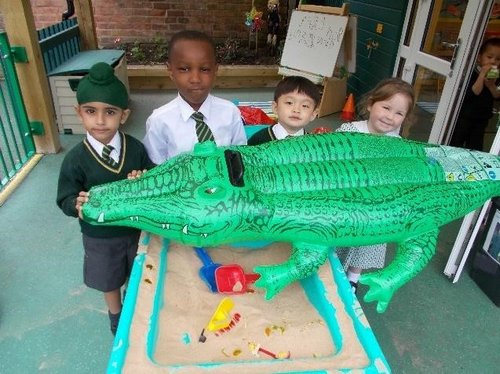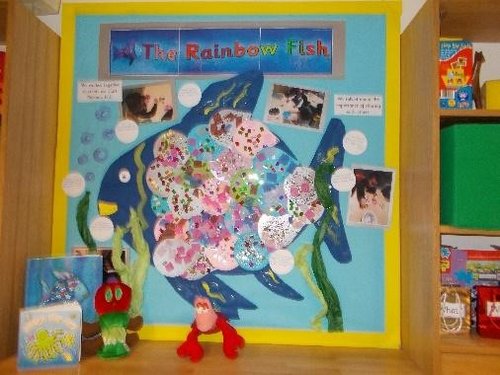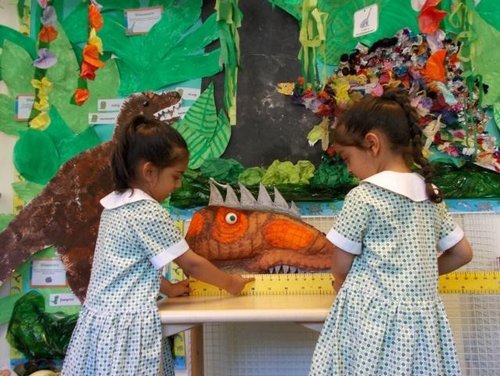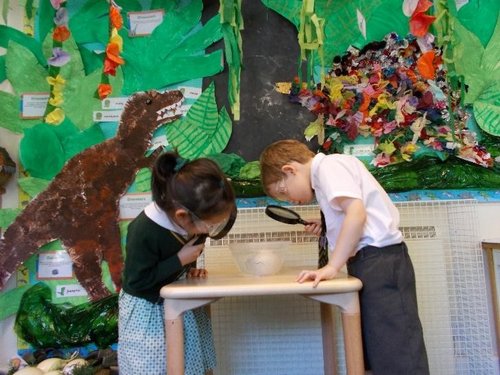I have written this article to exemplify how, at Norfolk House School, we develop critical thinking, possibility thinking and creativity within our Early Years Department setting our youngest children on a trajectory conducive to life-long learning.
We encourage a collaborative ‘learning curriculum’ environment enabling children to engage in their own learning. Therefore, it is the incidental learning within the hidden curriculum supplemented by the prescribed learning and teaching that constructs our curriculum which focuses on both the content and context of learning.
In this respect we believe that immersing the children in exciting topics is key; currently the Transition classroom has been transformed into the seaside and ‘treasure island’ complete with gold coins buried in sand, themed water play and even a blow-up crocodile. When I have been with the Transition children this term they have always displayed eagerness to show me how many gold coins they have counted in the treasure chest, vocabulary they can recognise, how the boats float in water, or how they are classifying materials such as shells and treasure. I have had many ‘delicious flavoured ice-creams’ made for me in the ‘Ice-cream Parlour’ role play area where the children have learned numerous number concepts using mathematical language.
The Reception children have created displays which transports you to a dinosaur swamp environment millions of years ago with an erupting volcano, enormous hatching dinosaur eggs, swooping pterodactyls above our heads and of course a terrifying Tyrannosaurus Rex to scare any visitor to our classroom. The children amaze me with their thirst for knowledge, research and enthusiasm for paleontology, natural history and science which has been stimulated by the topic.
Engaging interest and participation effectively nurtures the topics’ future course, thus extending learning experiences, complying with a creative approach to learning and teaching. The teachers and children have shared power as co-constructors; we teach the skills required and the children lead their use within their learning and play. This freedom following structured lessons fosters the inherent key features of teaching for creativity to help children develop their critical thinking: human engagement, a capacity to pose and solve problems within a playful and immersive context, innovation and risk taking, gives rise to independent learning.
A visitor to our Early Years classrooms can be forgiven for thinking the displays are purely for decoration; indeed we are always complimented on our imaginative and colourful exhibits, but they are an integral part of our teaching across the curriculum and linked to academic subjects.
Problem-solving is at the very heart of Mathematics. In its construction; numbers were invented so we could count and measure; humans created and defined properties and names of shapes enabling communication and understanding of the world. When used effectively, problem-solving becomes the vehicle for developing pupils’ mathematics and simultaneously helps develop autonomous decision-making and independence of thought and action. Within the topics we set up problem-solving situations that enable children to process and develop their mathematical content-knowledge and enhance their critical thinking.
Sensitive to the need for a certain amount of child-led, child-focused practice we allow for playful learning activities within our interactive displays by providing subject-led resources, thereby constructing a cross-curricular approach concerned with both the content and the context of learning. The learning roots originate in our teaching but through playful activities the children bring motivation, extending understanding of problem-solving by applying their own capacities to a self-initiated group activity. Peer support allows the children, some who may be puzzled at first, to explore the answers to their posed questions highlighting convergent thinking. Extending their own learning assisted by visual imagery through simple problem-solving methodology, and embracing the possibilities, the children often work out their own formula using logic.
Careful observation of each child highlights the pupil’s current level of understanding of generalised concepts, their acquisition of vocabulary and their application of the correct terminology which teachers have modelled in conjunction with practical learning activities. Interpreting the children’s responses prompt our experienced staff to carefully plan questioning, thus differentiating activities for those not yet secure and extending those with understanding. Very soon, learned concepts, having been taught through fun-based thematic approaches, can be substituted with different criteria, demonstrating the methodology of a solution to a real-life problem. Supporting the mental strategies required for critical thinking through a variety of fun-filled topics, asking a range of problems thus extends reasoning and possibility thinking.
In the Early Years we use principles of cross-curricular working and possibility thinking as a foundation for the children’s subject learning as the main thrust of planned lessons focusing on extending the curriculum experience. We endevour to make the whole experience meaningful, enabling learning through creativity. Combinations of subject areas flow together when the skills, knowledge and attitude of a number of disciplines are applied to a single experience, theme or idea. Watching the dinosaur egg hatch over an 8 day period has proved immensely exciting, stimulating fantastic language and research. The planned cross-curricular theme is a template for their learning experiences but allowing the learner to assume a more active role in the learning process, through socio-dramatic, child-initiated, guided/structured, and spontaneous playful activities to underpin children’s learning, the effectiveness of the curriculum is increased. As the children’s play is often shaped by their learning, this is evidence that our curriculum is intellectually engaging which is important for cognitive, social and emotional development, communication skills, self-initiated learning and challenge. The role of teacher is pivotal in a collaborative potentiating environment allowing for informed scaffolding strategies to support each child through appropriate subject-related vocabulary and exploration of ideas and experiences. This is based on knowledge of their interests, needs and dispositions thereby inviting children to actively participate in the learning process by their own initiative, sustaining interest and creativity. The concept of this creative approach provides a perspective conducive to generating curiosity, exploration, divergence, posing questions and making connections across the curriculum.
The children took their ‘palaeontology play’ very seriously, wearing safety spectacles and using brushes to carefully discover dinosaur eggs and fossils buried in sand. So many areas of development linked to one play activity; accumulating new language, improving dexterity and fine-motor control, enhancing an interest in Science and promoting communication skills and team work.
The Early Years curriculum at Norfolk House School subsequently encompasses a cross-curricular and holistic approach to children’s learning reflecting the features of teaching for creativity. Empowering our young children to build on their experiences in the Early Years Foundation Stage develops good practice for their transition into Key Stage 1 and I wish the Reception children well as they prepare to move up to Year 1.
Reporter:
Mrs Hifle
Head of Lower School
June 2018




